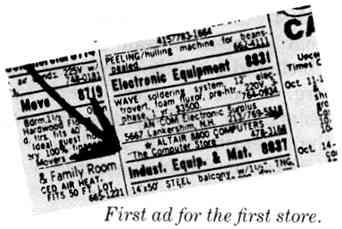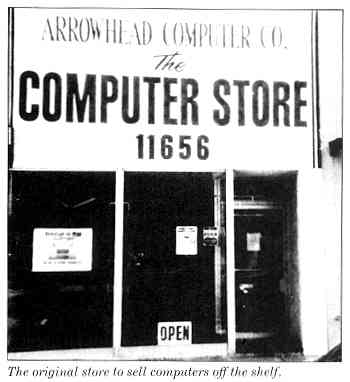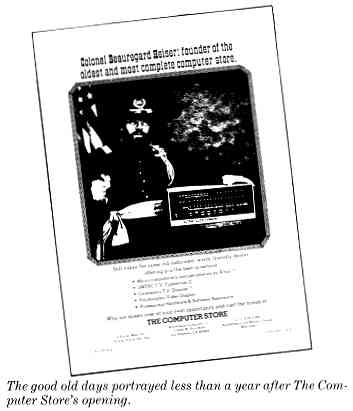STORE AGE
by Stephanie Rick

Stephanie Rick is the founder of We
Search Research a data search firm based in Venice, California.,
It was Father's Day,
1975, when Dick Heiser made his announcement to
the 125 people present at the organizational meeting of the Southern
California Computer Society. "I'm thinking of starting a computer
store," he said, "and if any of you have feedback or information I'd be
delighted to talk to you."
No one responded. There was a Radio Shack in the
neighborhood, after all, and in any event most computer owners ordered
parts and kits from ads in the back of magazines like Popular Mechanics
or out of Heathkit and Edmund Scientific catalogs.
Dick had left his job as a systems analyst for
Litton a couple of months before, thinking he would open a
computer-related bookstore. Then, in a spring 1975 issue of Scientific
American, he'd come across an ad for the first microcomputer-a
computer
based on an Intel 8-bit microprocessor and known as the MITS Altair. He
sent for more information and received literature that was "full of
typographical errors. You could tell they were in a start-up situation."
In May he got his first look at the Altair when he
attended the National Computer Conference in Anaheim. It ran BASIC as a
language, could be used as a text editor, and at $4,000 was affordable
by computer standards. Two years before, Dick had paid $14,000 for his
Computer Animation minicomputer, and he quickly decided to sell it.
After that conference Dick was invited to attend a
showing of the Altair in Van Nuys, where so many people showed up that
they quickly filled the room and overflowed into the hall. The MITS
representative had only begun his first sentence about the company's
history when he was interrupted by questions from the audience. People
were there for real information-many of them either already owned an
Altair, had one on order or were planning to order one soon-and the
questions continued for two hours. It was at that meeting that Dick
first realized that microcomputers were a real business.
Ignoring the apparent lack of interest in a computer
retail store, and undaunted by the bank's refusal to grant them a loan
("Come back when you've been in business for a year"), Dick and his
wife Lois went to their parents for financial help. They leased 1,200
square feet of space in what Dick called a "convenient but seedy
neighborhood of West Los Angeles." Still, at $225 per month, the rent
was not prohibitive, and on July 15, 1975, The Computer Store opened
for business.
There was no Grand Opening celebration. Publicity
had consisted of a few fliers, since Dick was still soldering in the
back room. The first ad, however, just two lines of copy under
"Electronic Equipment" in the classified section of the Los Angeles
Times, pulled in computer hobbyists from all over the city; the next ad
was a little larger-one column inch of the same classified section.
Patrons of the restaurant across the street would see the store's sign
and come over to laugh, but The Computer Store grossed $10,000 in its
first month of operation.

The store carried kits for the Altair 8800, some
peripheral devices and thirty book titles, among them 101 Basic Games
by David Ahl and What to Do After
You Hit Return by Robert Albrecht. An
Altair 8K system, hooked up to a television typewriter, was used for
demonstrations and playing games. Most customers went to the books
first. "It gives them a chance to become comfortable," said Lois in the
November 1975 issue of Datamation.
It was a good way to break through
the tension; almost nobody, including the Heisers, had any idea what a
computer store was, though Dick had an idea of what it should be. He'd
worked for IBM at one time and liked their "solution sale" approach to
business-first find out what is needed, then come up with an answer. He
designed his store to be information-oriented and focused on systems
rather than parts and experimental kits.
Most software, such as MODMON, an early
general-purpose program that preceded the more sophisticated disk
operating systems, was written in-house. The store wrote no accounting
programs, however, and thus avoided lawsuits over programs that ate
business records, did not conform to specific accounting standards or
just flatly would not run. In fact, the store sold no applications
software. Instead, it customized systems programs and languages to link
different types of equipment according to clients' needs.
Although there were some physicians and small
companies using the Altair for business purposes, the first home
computer customers were for the most part amateur radio ("ham")
operators, electronics hobbyists, and engineers and programmers from
technical and aerospace companies. While some wanted their computers
fully assembled, most were happy with kits-especially since they now
had a local place where they could buy components or get their
questions answered. The most common reason they wanted a computer was,
they sheepishly admitted, to play games.
Cash flow was a constant problem for Dick in the
early days. Orders to MITS had to be prepaid. "I thought that was a
strange way to do business," Dick recalls, "but there didn't seem to be
any other way. At one point MITS had all our money and some of our
customers' money and we didn't have any inventory in the store."
Nevertheless The Computer Store grew quickly. In
October Lois left her job running a software project in model building
at the Rand Corporation to help out, and Dick began hiring a small
staff. Within a year, the store-which Ed Roberts, then president of
MITS, said looked like "you could pack it into a suitcase"needed more
room.

The Computer Store moved to its present Santa Monica
location in the spring of 1976. In July of that year there were fifty
stores selling microcomputer products across the United States; by July
1977 there were over five hundred. Though many of them did not succeed
in keeping their doors open, in mid-1983 Future Computing, a market
research firm dedicated exclusively to the personal computer industry,
conducted a survey that yielded responses from 2,479 stores. The number
of stores is expected to reach six to seven thousand by 1988. One
change already noticeable is a decrease in the number of
single-location, independent stores and the increasing dominance of
retail chain stores and franchises.
The Computer Store itself has undergone some
changes. In 1978 the store was dropped as an Altair dealer; by 1979 the
Altair was no longer manufactured. The store now sells several lines of
personal computers, including Apple, Kaypro, Vector Graphic and Altos.
Dick Heiser is no longer the owner; he sold the store to Brian Donner
in 1982, and is designing and teaching computer courses, writing
documentation and looking into the future. The store's clientele is a
little older and has expanded to include smallbusiness owners,
middle-management personnel and a vast collection of people known as
"home computer users." There is less tech-talk going on, and customers
are increasingly focused on costs of systems rather than services.
Despite the projections about franchises and retail
chains, this single-location, independently owned store is thriving.
It's still one of the best places to get a question answered if it has
anything to do with computers, and it's
still a bit of the future, as it was in 1975, existing in the present.
Return to Table of Contents | Previous Article | Next Article

